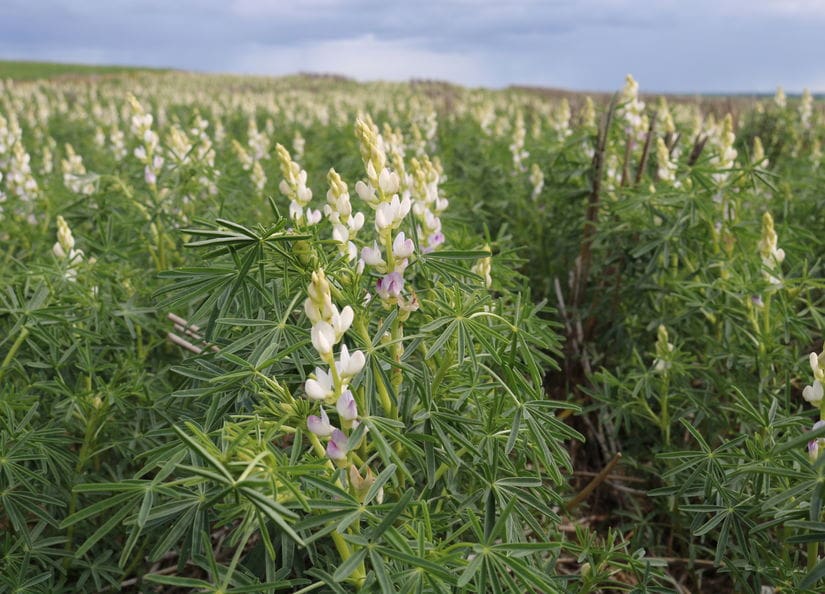
Gidgee is one of the new lupin varieties which holds promise for a stabilisation or rebuild in WA’s lupin area. Photo: AGT
CANOLA has supplanted lupins as the crop of choice to rotate with wheat on many Western Australian farms, but some growers are sticking with lupins, now that new varieties and more diverse markets are helping to shield the pulse from price shocks caused by drops in the global protein complex.
WA’s lupin production in many years has exceeded 1 million tonnes, most recently in 2005-06, and planted area exceeded 1 million hectares for much of the 1990s.
Lupins in 2022-23, WA’s biggest ever winter-cropping year, covered 400,000ha and yielded 925,000t.
In contrast, canola covered a record 2.1Mha and yielded a record 4.3Mt in 2022-23, following a steady climb from 437,000ha yielding 617,000t in 2005-06.
As detailed in the latest Grain Industry of WA Crop Report released last week, production of both crops is expected to be well down in WA this year as the impact of a dry growing season bites.
Beyond bulk
WA has four major export markets for lupins primarily supplied by deliveries to CBH Group’s network: Europe, South Korea, The Philippines, and Vietnam.
They primarily buy WA lupins in bulk, and demand from Asian destinations spikes when soymeal and canola meal become prohibitively expensive to buy for feed rations.
Europe’s demand is less elastic, and calls for lupins with very low residual levels of diquat and paraquat herbicide.
Premium Grain Handlers is a major exporter of containerised WA lupins and ships around 50,000-60,000t annually to all destinations including Europe.
PGH last year built and filled a 15,000-tonne storage between Geraldton and Perth to accumulate lupins to specifications needed to access the European market.
“We built a storage at Dandaragan to take ‘quat-free lupin, because we didn’t want those ones to be turfed into the network,” PGH accumulation manager Jackson Morris said.
“Last year, we completely filled that shed; we sent samples to the lab, and not one of them was pinged by ‘quat, which was fantastic.”
The Dandaragan facility enables PGH to differentiate product aimed at the European market, and bids at around $10/t over comingled deliveries.
“We’re trying to show growers there is a premium.
“The response is a bit mixed; some say that’s worthwhile, others say it’s not.”
In the Geraldton and Kwinana North zones, traditionally WA’s heartland of lupin production, canola and lupin yields can be similar, but canola’s value per tonne has been around double or more that of lupins in recent years.
“At seeding, lupins were $290-$300/t delivered depot; that’s a pretty poor farm-gate price, so it’s easy for growers to throw them out and go for canola at $800/t.”
Lupins do, however, hold two broader advantages: their ability to fix nitrogen in the soil, in contrast to canola which has a big appetite for N, and their suitability for use in on-farm feed rations for sheep.
Mr Morris said domestic demand for lupins has been fairly consistent, but export drives the overall price complex.
“Last year, WA had a good crop and great yields, and the price got down to $270/t in the Geraldton zone.
“No-one wants to plant for those prices, so now the price is more like $450/t.”
Mr Morris estimates the average lupin price delivered depot over the past decade would be around $350/t, with a high near $500/t achieved in 2020-21.
ABARES estimates the lupin area now being harvested is 250,000ha, the lowest since 246,000ha in 2013-14, while the state’s canola area is forecast at 1.8Mha.
Hope for new varieties
GIWA Crop Report author, leading agronomist, and SLR Agriculture director Michael Lamond said older lupin varieties’ contribution to some soils becoming non-wetting have made the crop unattractive from an agronomic as well as a price perspective.
“Wax in the leaf has become a real issue,” Mr Lamond said.
After being grown by some since the 1990s or earlier, this has caused staggered or generally poor emergence in some paddocks, and prompted the need for expensive soil-amelioration programs in parts of the Geraldton and Kwinana North zones.
“In the same time this has occurred, we’ve seen the new type of lupin which is more determinant.”
He said the arrival of the new varieties, which produce less leaf and more grain, point to the future of lupins in WA thanks to some targets being hit by breeders.
“They’ve realised we don’t want to grow 6-8t/ha of biomass and 2t/ha of lupin.”
Mr Lamond said WA’s lupin area was already shifting out of the Geraldton and Kwinana North zones to southern regions.
“Soils in southern regions have more clay content, so they don’t become as non-wetting as quickly.”
Some specialist human-consumption uses of lupins are developing, and include demand from non-dairy milk such as OatUP, made by WA’s Wide Open Agriculture.
Mr Lamond said it was these, rather than the bulk commodity market for stockfeed, that could prompt an increase in WA’s lupin area in years to come.
“There’s nothing in the short term to indicate lupin area will increase, but the medium term, as we transition from feed to food, might be different.”
Get our free news straight to your inbox – Click here

HAVE YOUR SAY